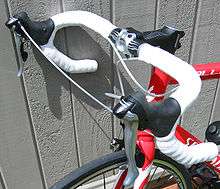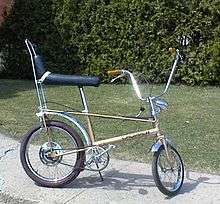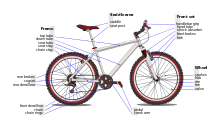Shifter (bicycle part)


A bicycle shifter or gear control or gear levers is a component used to control the gearing mechanisms and select the desired gear ratio. Typically, they operate either a derailleur mechanism or an internal hub gear mechanism. In either case, the control is operated by moving a cable that connects the shifter to the gear mechanism. Shifters are mounted on the down tube of the frame, stem, or various locations on the handlebars. Manufacturers of shifters include Shimano, Campagnolo, Microshift, Sturmey Archer, and SRAM.
Shifter controls are mounted so that the right shifter controls the rear derailleur and the left shifter controls the front derailleur. For hub gears, the control is also mounted on the right.
Various shifters designs have included friction shifters and index shifters, which do not require fine-tuning during a gear change, as well as shifters integrated with the brake controls.
Friction shifting
Originally, gear control levers consisted of a simple lever. Changing gears required pushing or pulling the lever so that the derailleur would move the chain to a different sprocket on the rear hub. The cyclist would need to adjust the lever to center the chain on the sprocket.
This system started out with 2 or 3 sprockets, and by the 1970s had developed to 5 and 6 sprockets. Many inexperienced cyclists, especially those who started in the US 1970s bike boom, found it difficult to change gear accurately. Typical difficulties included gear changes that left the chain in between two sprockets, which causes noisy rattles, or undesired and unexpected gear changes. However, many experienced cyclists still prefer friction gears for their simplicity and long-term reliability, as well as the ability to mix and match components from different manufacturers without the compatibility issues of indexing systems. Another benefit of friction shifting is the ability to shift from the lowest to highest gear in one simple motion. In addition, the introduction of ramped freewheel sprockets (such as Shimano's Hyperglide system) and derailleurs with floating jockey wheels has made accurate gear changes much easier than previously. Friction or ratcheting shifters remain popular for front derailleurs, since only two or three chainrings are used, and allow trimming of the front derailleur.
Index shifting
Index shifting is a system where the control has discrete stops. Hub gears by design are indexed, but for derailleur systems, indexing was an innovation. Each stop corresponds to one position of the derailleur. This allows the cyclist to change gear without having to adjust each time, as in friction shifting.
The first successful indexed shifting system was the Shimano Index Shifting or SIS, introduced in 1984 on the 6-speed Dura-Ace racing groupset. This made it near impossible to misshift, but at the expense of having more difficult initial adjustment. Most modern bikes made today are equipped with index shifting. Prior to this, Shimano had sold a system called Positron, in which the indexing mechanism was placed in the derailleur; however this system was only targeted at cheaper bicycles and gained a bad reputation. In all modern indexed shifting systems, the indexing mechanism is placed in the shifters.
Index shifter styles include twist shifters, trigger shifters (such as Shimano's Rapidfire design), shifters integrated with brake levers, levers mounted on the downtube, and bar-end controls. A twist shifter is mounted in line with the handlebar grips. Shifting is controlled by rotating the grip of the shifter. Trigger shifters have separate levers that change gears to the next gear up or down. Early indexed shifters could be used in friction mode for backwards compatibility, but this feature is no longer common.
New mountain bicycles use either twist shifters or trigger shifters. Older mountain bicycles may have thumb shifters, often indexed for the rear derailleur and friction for the front. Shimano's Deore, LX, XT, and XTR mountain groupsets include combined brake/shift controls, called Dual-control. Moving the brake lever perpendicular to the direction to control the brakes operates the shift mechanism.
Given that friction shifters were compatible with almost any derailleur, index shifting systems have been criticized for their non-interchangeability. For example, Shimano indexing components are often incompatible with SRAM or Campagnolo components, because the amount of cable pulled between each "click" is different in each system. For example, a typical Shimano (2:1), 7-speed shifter changes the cable length by 2.9mm between each gear, while a similar 7-speed SRAM (1:1) shifter changes the cable length by 4.5mm; some other SRAM units, (that differ only by an MRX designator), are compatible with Shimano units. In addition, newer components are often not backward compatible with older systems from the same manufacturer, so finding spares for older systems is often difficult, and stocking all of the possible combinations (shifters, derailleurs, chainrings, freewheels, and cassettes) is a challenge for the local bike shop. Some components can be mixed and matched between systems, but it can be a bit of a kludge to do so. Component manufacturers have been accused of planned obsolescence for introducing more and more complicated shifting systems—and withdrawing support for older systems—to a riding public which generally doesn't need so many gears for basic transport, utility, or recreational cycling.
One notable exception to the lack of compatibility in modern shifters is the fact that none of Campagnolo's front shifters are indexed, so they are compatible with all double or triple cranksets, even those of different manufacturers. Campagnolo rear shifters are also partially backwards compatible because a mechanic can upgrade them for use with a different number of rear sprockets by replacing a small part, the shift disc.
Shifter designs
Older road bike shifters may be down tube gear levers, mounted on the down tube of the frame. These have been available both non-indexed (friction) and indexed. If the levers are not mounted on the handlebar, the rider would have to move a hand from the handlebars to the gear lever to change gears. This made changing gears difficult while turning, going up hill, maneuvering in traffic, or during a race, as the rider would lose some stability from having only one hand on the handle bar, while adjusting the lever. Friction shifters have the added disadvantage of having to be trimmed every time the gear was changed, which might take a few moments. This led riders to usually stay in one gear, unless they were about to rapidly change their speed. Indexed shifters addressed the trimming issue, but the stability issue remained.
Thumb shifters are simple shifters which used to be common on mountain bikes, essentially being a downtube shifter mounted on top of the handlebars. Stem-mounted shifters are also similar. These gave way to twist-grip shifters as developed by SRAM, which remain common on flat handlebars. 'Rapidfire' or trigger shifters use two triggers below the handlebar, one to change up and another to change down.
Combined brake and shift levers

With the introduction of systems such as Shimano Total Integration, Campagnolo ErgoPower, and the more recent SRAM Double Tap systems, the majority of these issues have been addressed. These systems combine a trigger shifter into each brake lever, and were sometimes referred to as brake/shift levers (or brifters), for their ability to combine the brake and shift functions into a single unit for use with one hand. However, in recent times, the term brake has been dropped, and the levers are referred to simply as shifters or integrated shifters. These integrated shifters, when combined with gear ramps and teeth shaping on the cassette, address most of the issues with friction and index shifters.
Advantages
Integrated shifters allow for rapid and precise shifting, without removing the hands from the handlebars. This system has been combined with gear ramps and tooth shaping on the cassette to allow for the chain to transfer power while shifting. This allows more frequent shifting to allow the desired cadence, an especially useful capability in traffic or during a race. The cyclist can accelerate more rapidly (thanks to rapid up shifting while pedaling), maintain a straighter line while accelerating (such as while riding along a curb in traffic, or during a race), and downshift while approaching an intersection or a hill. The ability to rapidly shift allows a cyclist to better maintain a good cadence and therefore cycle faster with less effort.
For touring cyclists and recreational riders who use drop bars, integrated shifters may make riding easier and more comfortable, as they allow the rider to use more hand positions and also retain access to both the brakes and gear shifters at the same time.
In general, the additional weight, expense, and occasional maintenance of shifters on a road bicycle is far outweighed by the performance advantages in a racing context.
Disadvantages
Integrated shifters are not without their disadvantages; the system is more complicated and subject to greater wear and tear than previous systems, especially friction shifters. Due to their greater number of parts, index shifters are more expensive and less reliable than friction shifters. Index shifters rely on uniform cable tension, but over time the derailleur cable will stretch, causing the system to slowly drift to the right of the gear. In addition integrated shifters need a considerable amount of additional gear cable and housing compared to downtube mounted shifters, this leads to more friction and so less responsive shifting. Periodic adjustments are required.
Variations

Besides the mainstream varieties mentioned above; twist shifters, trigger shifters, shifters integrated with brake levers, and levers mounted on the downtube; several other variations have been offered.
Bar-end shift levers
Because of the increased desire of the time trialist for an aerodynamic position on the bicycle, a time trial bike uses triathlon bars, a different bar arrangement from a road bicycle's drop handlebars. The controls are mounted at the end of the triathlon bars and are called bar-end levers or barcon, for bar control. Bar-end gear levers can also be used on the ends of drop handlebars, a set-up common on touring bicycles, as bar-end shifters are more robust than integrated shifters.
Electronic gear-shifting system
An electronic gear-shifting system on a bicycle is a new method of changing gears, which enables riders to shift with a light touch of two electronic switches instead of using the conventional control levers. The switches are electronically connected to a battery pack, which is connected by wires to a small motor that drives the electric derailleurs, switching the chain from gear to gear.
Automotive-style
A popular feature on wheelie bikes was a shifter that resembled the gear shifter in muscle cars.
See also
References
| Wikimedia Commons has media related to Bicycle gear shift levers. |
